Dynamics and Pretransitional Effects in C60 Fullerene Nanoparticles and Liquid Crystalline Dodecylcyanobiphenyl (12CB) Hybrid System
Abstract
1. Introduction
2. Materials and Methods
2.1. Samples Preparation
2.2. Experimental Procedures
2.3. Data Analysis and Modeling
3. Results and Discussion
4. Conclusions
- The evidence showing that even a tiny (very small concentration) addition of fullerenes can strongly change the dielectric constant (coupled to the arrangement of dipole moments) and the maximum of the primary loss curve (coupled to the energy associated with the given relaxation process).
- The temperature evolution of the above properties is related to the isotropic–Smectic A transition, in the liquid phase up to and in the whole smectic phase.
- The addition of fullerenes does not change the functional forms of pretransitional anomalies, particularly the value of the “critical” exponent.
- There are hallmarks of the pretransitional effect for the SmA–Solid transition, enhanced by the addition of fullerenes.
- The increase in the number of fullerenes shifts dynamics from the clear SA (“glassy”) pattern to the (almost) Arrhenius pattern, and finally back to SA scaling again.
- The Landau–de Gennes phenomenological model is the base for portraying phase transition impact in liquid crystals, mainly related to thermodynamic and static properties. This report shows that it can be extended to describe composites of smectogenic LC and nanoparticles (fullerenes) and obtain the SA-A–SA crossover in dynamics when changing the concentration of fullerenes.
Author Contributions
Funding
Conflicts of Interest
References
- Goodby, J.W.; Collings, P.J.; Kato, T.; Tschierske, C.; Gleeson, H.; Raynes, P. Handbook of Liquid Crystals: Volume 2: Physical Properties and Phase Behavior of Liquid Crystals; Wiley: New York, NY, USA, 2014. [Google Scholar]
- Salam, A.; Makhlouf, H.; Barhoum, A. Fundamentals of Nanoparticles: Classifications, Synthesis Methods, Properties and Characterization; Elsevier: Amsterdam, The Netherlands, 2018. [Google Scholar]
- Dierking, I. (Ed.) Nanomaterials in Liquid Crystals. Nanomaterials 2017, 8, 453. [Google Scholar]
- Lagerwall, J.P.F. (Ed.) Liquid Crystals with Nano and Microparticles: Series in Soft Condensed Matter; World Scientific Publishing: Singapore, 2017. [Google Scholar]
- Garbovskiy, Y.; Glushchenko, A. Ferroelectric nanoparticles in liquid crystals: Recent progress and current challenges. Nanomaterials 2017, 7, 361. [Google Scholar] [CrossRef] [PubMed]
- Munna, M.; Anwar, F.; Coutu, R.A., Jr. Nematic liquid crystal composite materials for dc and rf switching. Technologies 2019, 7, 32. [Google Scholar] [CrossRef]
- Qui, H.; Hegmann, T. Liquid crystal–gold nanoparticle composites. Liq. Cryst. Today 2011, 20, 102–114. [Google Scholar] [CrossRef]
- Antypov, D.; Cleaver, D.J. The role of attractive interactions in rod–sphere mixtures. J. Chem. Phys. 2004, 120, 10307–11016. [Google Scholar] [CrossRef]
- da Cruz, C.; Sandre, O.; Cabuli, V. Phase behavior of nanoparticles in a thermotropic liquid crystal. J. Phys. Chem. B 2005, 109, 14292–14299. [Google Scholar] [CrossRef]
- Nealon, G.L.; Greget, R.; Dominguez, C.; Nagy, Z.T.; Guillon, D.; Gallani, J.-L.; Donnio, B. Liquid-crystalline nanoparticles: Hybrid design and mesophase structures. Beilstein J. Org. Chem. 2012, 8, 349–370. [Google Scholar] [CrossRef]
- Bakker, H.E.; Dussi, S.; Barbera Droste, L.; Besseling, T.H.; Kennedy, C.L.; Wiegant, E.I.; Liu, B.; Imhof, A.; Dijkstra, M.; van Blaaderen, A.S. Phase diagram of binary colloidal rod-sphere mixtures from a 3D real-space analysis of sedimentation–diffusion equilibria. Soft Matter 2016, 12, 9238–9245. [Google Scholar] [CrossRef]
- Saielli, G.; Margola, T.; Satoh, K. Tuning Coulombic interactions to stabilize nematic and smectic ionic liquid crystal phases in mixtures of charged soft ellipsoids and spheres. Soft Matter 2017, 13, 5204–5213. [Google Scholar] [CrossRef]
- Saielli, G.; Satoh, K. Coarse-grained model of ionic liquid crystals: The effect of stoichiometry on the stability of the ionic nematic phase. Phys. Chem. Chem. Phys. 2019, 21, 20327–20337. [Google Scholar] [CrossRef]
- Črešnar, D.; Kyrou, C.; Lelidis, I.; Drozd-Rzoska, A.; Starzonek, S.; Rzoska, S.J.; Kutnjak, Z.; Kralj, S. Impact of weak nanoparticle induced disorder on nematic ordering. Crystals 2019, 9, 171. [Google Scholar] [CrossRef]
- Singh, K.N.; Singh, N.M.; Sharma, H.B.; Alapati, P.R. Dielectric relaxation studies of silver nanoparticles dispersed liquid crystal. J. Adv. Phys. 2015, 8, 2176–2188. [Google Scholar] [CrossRef]
- Porov, P.; Chandel, V.S.; Manohar, R. Dielectric and electro-optical properties of ceramic nanoparticles doped liquid crystals. Trans. Electr. Electron. Mater. 2016, 17, 69–78. [Google Scholar] [CrossRef]
- Rzoska, S.J.; Starzonek, S.; Drozd-Rzoska, A.; Czupryński, K.; Chmiel, K.; Gaura, G.; Michulec, A.; Szczypek, B.; Walas, W. The impact of BaTiO3 nanonoparticles on pretransitional effects in liquid crystalline dodecylcyanobiphenyl. Phys. Rev. E 2016, 93, 534. [Google Scholar] [CrossRef]
- Starzonek, S.; Rzoska, S.J.; Drozd-Rzoska, A.; Czupryński, K.; Kralj, S. Impact of ferroelectric/superparaelectric nanoparticles on phase transitions and dynamics in nematic liquid crystal. Phys. Rev. E 2017, 96, 022705. [Google Scholar] [CrossRef] [PubMed]
- Drozd-Rzoska, A.; Starzonek, S.; Rzoska, S.J.; Kralj, S. Nanoparticles controlled glassy dynamics in nematogen-based nanocolloids. Phys. Rev. E 2019, 99, 0502703. [Google Scholar] [CrossRef] [PubMed]
- Kamanina, N.V.; Kaporskii, L.N. The effect of fullerenes on the dynamic characteristics of liquid crystal systems. Technic. Phys. Lett. 2000, 26, 864–866. [Google Scholar] [CrossRef]
- Shah, H.J.; Fontecchio, A.K.; Mattia, D.; Gogotsi, I.Y. Field controlled nematic-to-isotropic phase transition in liquid crystal–carbon nanotube composites. J. Appl. Phys. 2008, 103, 064314. [Google Scholar] [CrossRef]
- Srivastava, A.K.; Kim, M.; Kim, S.H.; Kim, M.K.; Lee, K.; Lee, Y.H.; Lee, M.H.; Lee, S.H.; Lee, Y. Dielectrophoretic and electrophoretic force analysis of colloidal fullerenes in a nematic liquid-crystal medium. Phys. Rev. E 2009, 80, 051702. [Google Scholar] [CrossRef]
- Vovk, V.E.; Kovalchuk, O.V.; Gorishnyj, M.P.; Kovalchuk, T.M. Dielectric and electro-optical properties of solutions of chemically modified fullerene C60 in nematic liquid crystal. Semicond. Phys. Quant. Elect. Optoelect. 2011, 14, 256–260. [Google Scholar] [CrossRef][Green Version]
- Al-Zangana, S.; Iliut, M.; Boran, G.; Turner, M.; Vijayaraghavan, A.; Dierking, I. Dielectric spectroscopy of isotropic liquids and liquid crystal phases with dispersed graphene oxide. Sci. Rep. 2016, 6, 31885. [Google Scholar] [CrossRef] [PubMed]
- Sami, S.; Pi, A.B.; Haase, R.; Alessandri, R.; Broer, R.; Havenith, R. Can the dielectric constant of fullerene derivatives be enhanced by side chain manipulation? A predictive first principles computational study. J. Phys. Chem. A 2018, 122, 3919–3926. [Google Scholar] [CrossRef] [PubMed]
- Omena, L.; de Melo, P.B.; Pereira, M.S.; de Oliveira, I.N. Effects of fullerene addition on the thermo-optical properties of smectic liquid crystals at the vicinity of the nematic-smectic-A phase transition. Phys. Rev. E 2014, 89, 052511. [Google Scholar] [CrossRef] [PubMed]
- Shukla, R.K.; Raina, K.K.; Haase, W. Fast switching response and dielectric behaviour of fullerene/ferroelectric liquid crystal nanocolloids. Liq. Cryst. 2014, 41, 1726–1732. [Google Scholar] [CrossRef]
- Bronnikov, S.; Podshivalov, A.; Kostromin, S.; Asandulesa, M.; Cozan, V. Dielectric spectroscopy investigation on relaxation in polyazomethine/fullerne C60 nanocomposites. Eur. Polym. J. 2016, 78, 213–225. [Google Scholar] [CrossRef]
- Bourg, M.; Urbanski, M. Spectroscopic insight into molecular fluctuations and phase stability of nematic composites containing gold nanoparticles or carbon nanotubes. Phys. Chem. Chem. Phys. 2017, 34, 1–7. [Google Scholar] [CrossRef]
- Zhang, X.; Yu, B.; Cong, H. Recent developments in fullerene-containing thermotropic liquid crystals. Curr. Org. Chem. 2017, 21, 1600–1611. [Google Scholar] [CrossRef]
- Stelson, A.C.; Penterman, S.J.; Liddell Watson, C.M. Electric field-directed assembly of fullerene crystal rods into hierarchical films. J. Mater. Chem. C 2018, 6, 11118–11127. [Google Scholar] [CrossRef]
- Zubtsova, Y.A.; Kamanina, N.V. The effect of fullerene on the temporal characteristics of a nematic liquid crystal-polyaniline-fullerene C60 system. Tech. Phys. Lett. 2018, 32, 582–585. [Google Scholar] [CrossRef]
- Ibragimov, T.D.; Imamaliyev, A.R.; Ganizade, G.F. Effect of fullerenes C60 on dielectric properties and the threshold voltage of smectic a liquid crystal. Mol. Cryst. Liq. Cryst. 2019, 691, 27–32. [Google Scholar] [CrossRef]
- Shen, P.; Lu, H.; Su, Z.; Zhou, Y.; Song, B.; Li, X.; Yang, X.; Tu, Y.; Li, C.Y. Effect of fullerene volume fraction on two-dimensional crystal-constructed supramolecular liquid crystals. Chem. Asian J. 2019, 14, 125–129. [Google Scholar] [CrossRef] [PubMed]
- Ibragimov, T.D.; Rzayev, R.M. Dielectric relaxation, electric conductivity, and electro-optic properties of SWCNT-doped liquid crystal 5CB. Fuller. Nanotub. Carbon Nanostruct. 2020, 28, 982–988. [Google Scholar] [CrossRef]
- Ibragimov, T.; Imamaliev, A.R.; Ganizade, G.F. The threshold voltage, dielelectric and conductivity properties of C60-doped smectic A liquid crystal. Fuller. Nanotub. Carbon Nanostruct. 2020, 28, 509–514. [Google Scholar] [CrossRef]
- Yang, X.; Tiantan, Z.; Tu, Y. Fullerene liquid crystals. In Liquid Crystalline Polymers; Zhu, L., Li, C.Y., Eds.; Springer: Berlin/Heidelberg, Germany, 2020; pp. 149–172. [Google Scholar]
- de Gennes, P.G.; Prost, J. The Physics of Liquid Crystals; Oxford Science Publishing: Oxford, UK, 1995. [Google Scholar]
- Chandrasekhar, S. Liquid Crystals; Cambridge University Press: Cambridge, UK, 2010. [Google Scholar]
- Kremer, F.; Schönhals, A. Broadband Dielectric Spectroscopy; Springer: Berlin/Heidelberg, Germany, 2003. [Google Scholar]
- Drozd-Rzoska, A.; Rzoska, S.J. Complex relaxation in the isotropic phase of n-pentylcyanobiphenyl in linear and nonlinear dielectric studies. Phys. Rev. E 2002, 65, 041701. [Google Scholar] [CrossRef] [PubMed]
- Rzoska, S.J.; Paluch, M.; Pawlus, S.; Drozd-Rzoska, A.; Jadzyn Czupryński, K.; Dąbrowski, R. Complex dielectric relaxation in supercooling and superpressing liquid-crystalline chiral isopentycyanobiphenyl. Phys. Rev. E 2003, 68, 031705. [Google Scholar] [CrossRef]
- Drozd-Rzoska, A.; Rzoska, S.J.; Pawlus, S.; Martinez-Garcia, J.C.; Tamarit, J.-L. Evidence for critical-like behavior in ultraslowing glass-forming systems. Phys. Rev. E 2010, 82, 031501. [Google Scholar] [CrossRef]
- Rzoska, S.J.; Drozd-Rzoska, A.; Martinez-Garcia, J.C.; Rzoska, S.J.; Drozd-Rzoska, A.; Martinez-Garcia, J. A universal description of ultraslow glass dynamics. Nat. Commun. 2013, 4, 1823–1830. [Google Scholar]
- Drozd-Rzoska, A. Universal behavior of the apparent fragility in ultraslow glass forming systems. Sci. Rep. 2019, 9, 6816. [Google Scholar] [CrossRef]
- Bradshaw, M.J.; Raynes, E.P. Pretransitional effects in the electric permittivity of cyano nematics. Mol. Cryst. Liq. Cryst. 1981, 72, 73–78. [Google Scholar] [CrossRef]
- Thoen, J.; Menu, G. Temperature dependence of the static relative permittivity of octylcyanobiphenyl (8CB). Mol. Cryst. Liq. Cryst. 1983, 97, 163–176. [Google Scholar] [CrossRef]
- Drozd-Rzoska, A.; Rzoska, S.J.; Zioło, J. Critical behaviour of dielectric permittivity in the isotropic phase of nematogens. Phys. Rev. E 1996, 54, 6452–6456. [Google Scholar] [CrossRef] [PubMed]
- Drozd-Rzoska, A.; Rzoska, S.J.; Zioło, J. The quasi-critical behavior of dielectric permittivity in the isotropic phase of smectogenic n-cyanobiphenyls. Phys. Rev. E 2000, 61, 5349–5354. [Google Scholar] [CrossRef] [PubMed]
- Drozd-Rzoska, A.; Rzoska, S.J.; Czupryński, K. Phase transitions from the isotropic liquid to liquid crystalline mesophases studied by “linear” and “nonlinear” static dielectric permittivity. Phys. Rev. E 2000, 61, 5355–5360. [Google Scholar] [CrossRef] [PubMed]
- Drozd Rzoska, A.; Rzoska, S.J.; Zioło, J.; Jadżyn, J. Quasi-ciritical behavior of the low-frequency dielectric permittivity in the isotropic phase of n-pentylcyanobiphenyl. Phys. Rev. E 2001, 63, 052701–052704. [Google Scholar] [CrossRef]
- Rzoska, S.J.; Zioło, J.; Sułkowski, W.; Jadżyn, J.; Czechowski, G. Fluidlike behavior of dielectric permittivity in a wide range of temperature above and below the nematic-isotropic transition. Phys. Rev. E 2001, 64, 052701. [Google Scholar] [CrossRef]
- Drozd-Rzoska, A.; Pawlus, S.; Rzoska, S.J. Pretransitional behavior of dielectric permittivity on approaching a clearing point in mixture of nematogens with antagonistic configurations of dipoles. Phys. Rev. E 2001, 64, 051701. [Google Scholar] [CrossRef]
- Drozd-Rzoska, A. Quasi-tricritical’ and glassy dielectric properties of a nematic liquid crystalline material. Crystals 2020, 10, 297. [Google Scholar] [CrossRef]
- Drozd-Rzoska, A.; Rzoska, S.J. On the derivative-based analysis for temperature and pressure evolution of dielectric relaxation times in vitrifying liquids. Phys. Rev. E 2006, 73, 041502. [Google Scholar] [CrossRef]
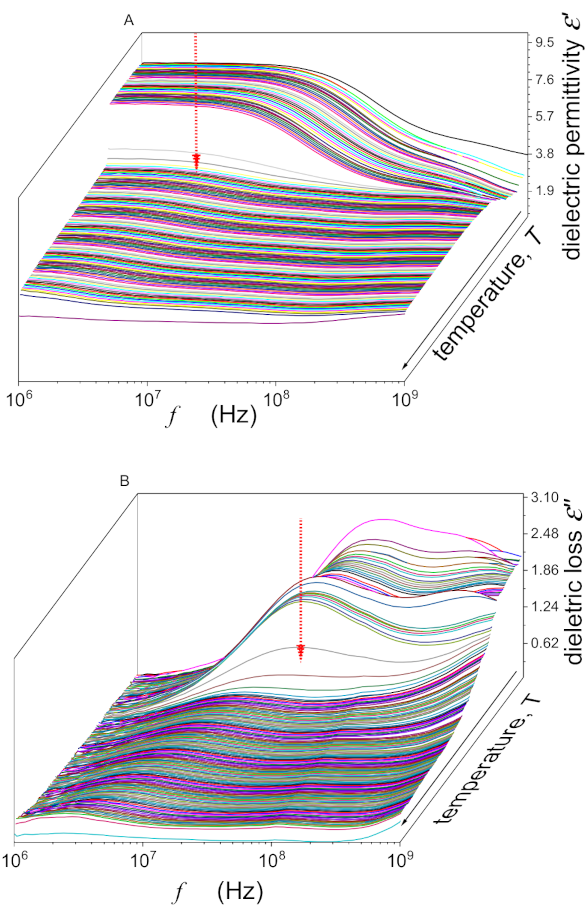
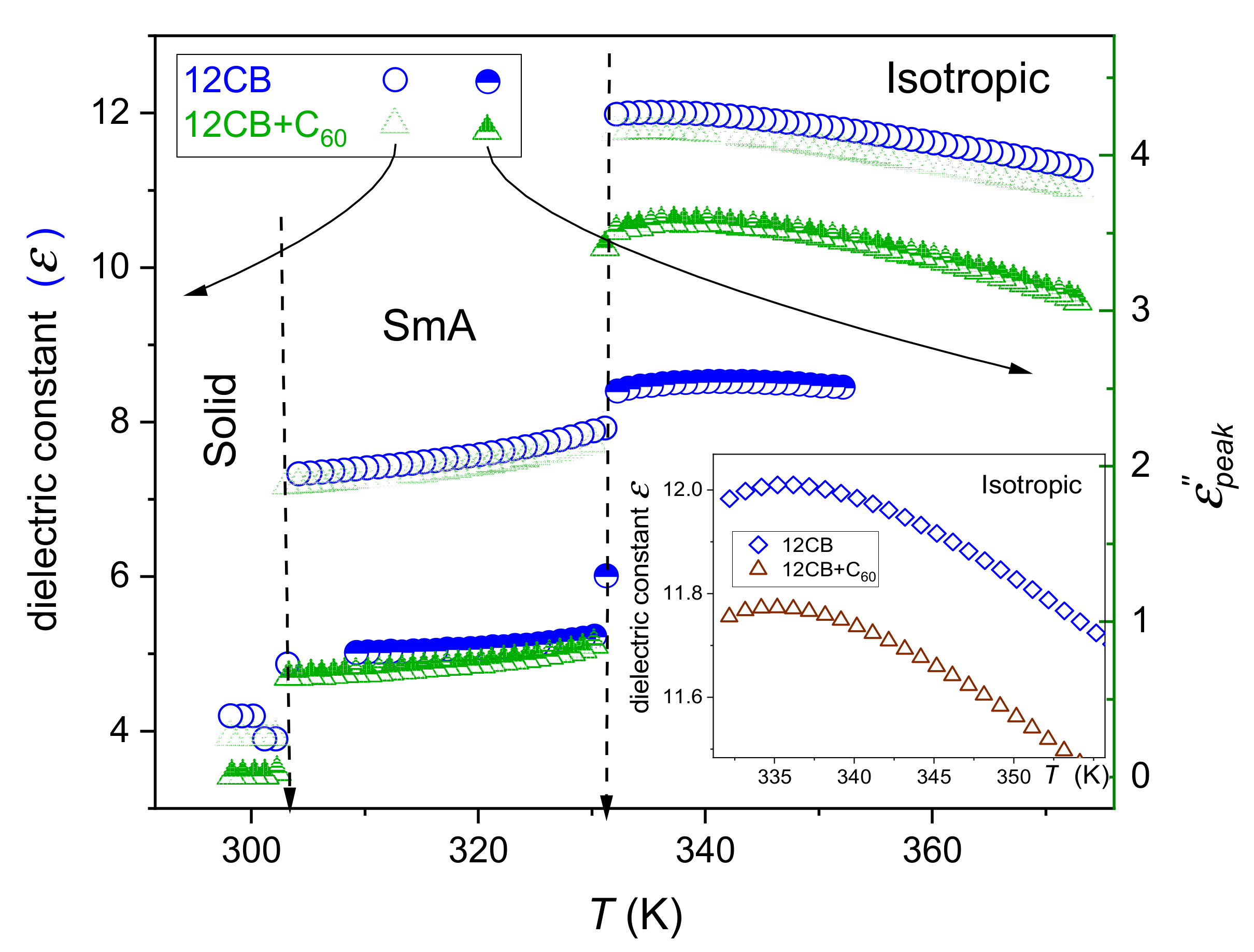
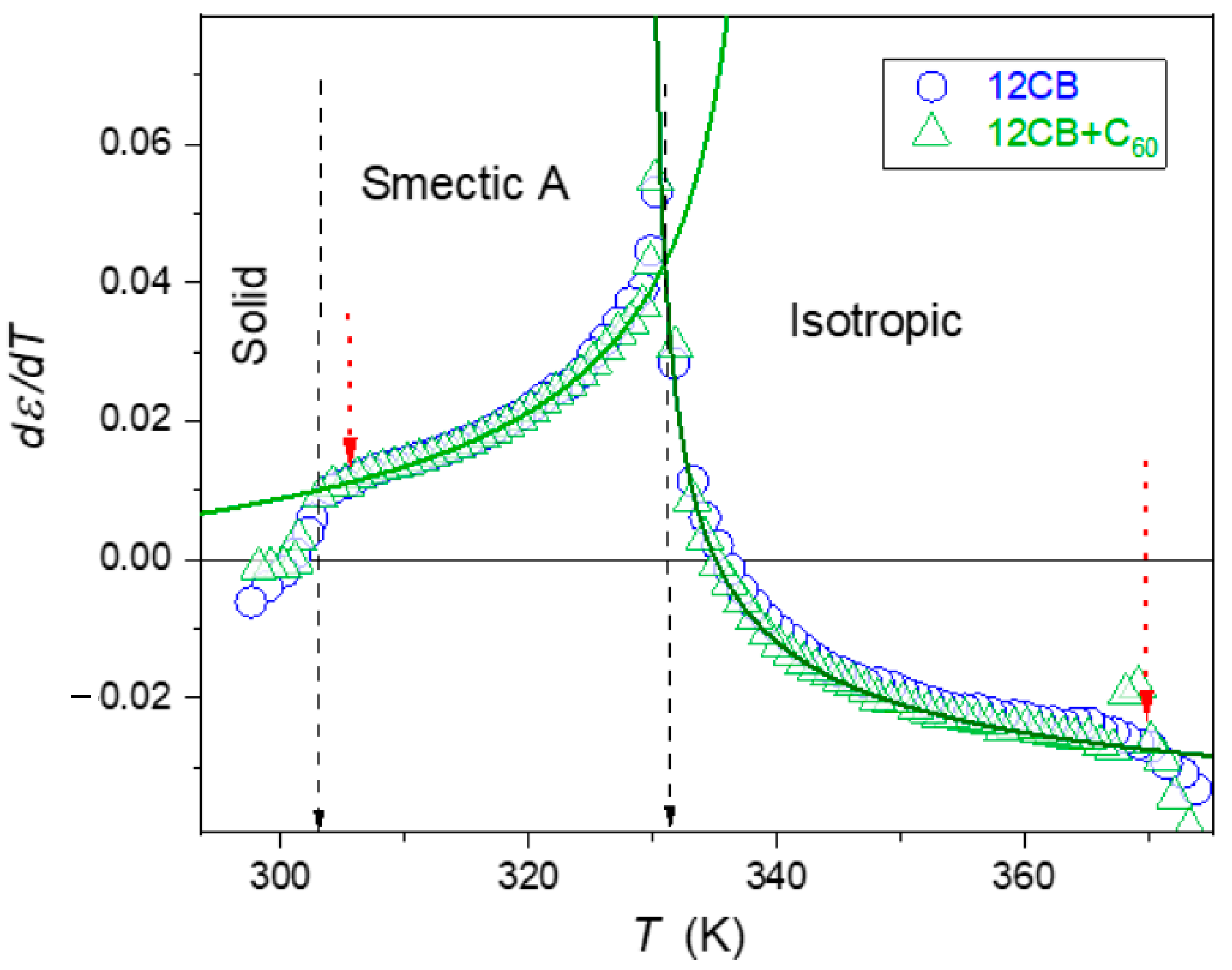
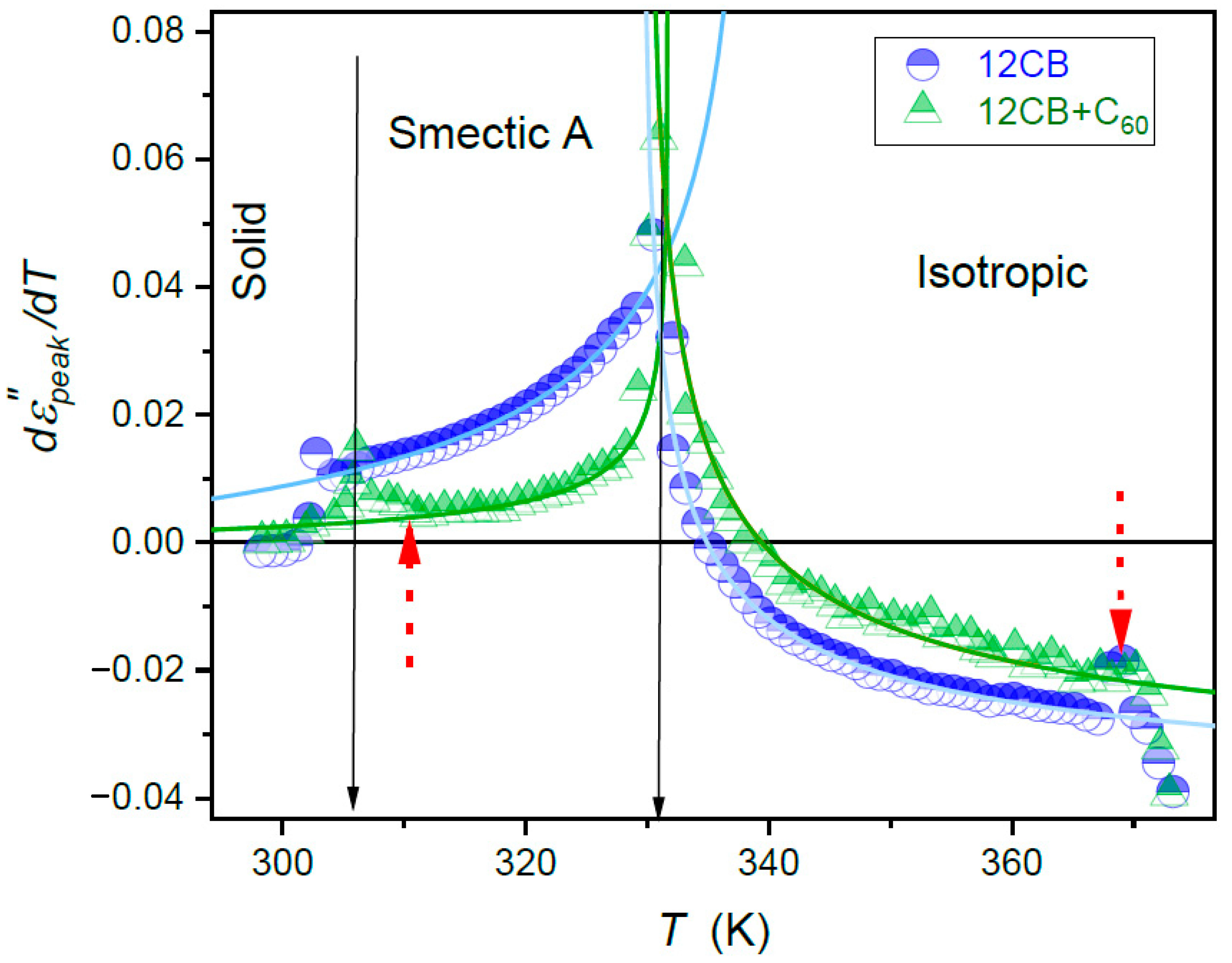
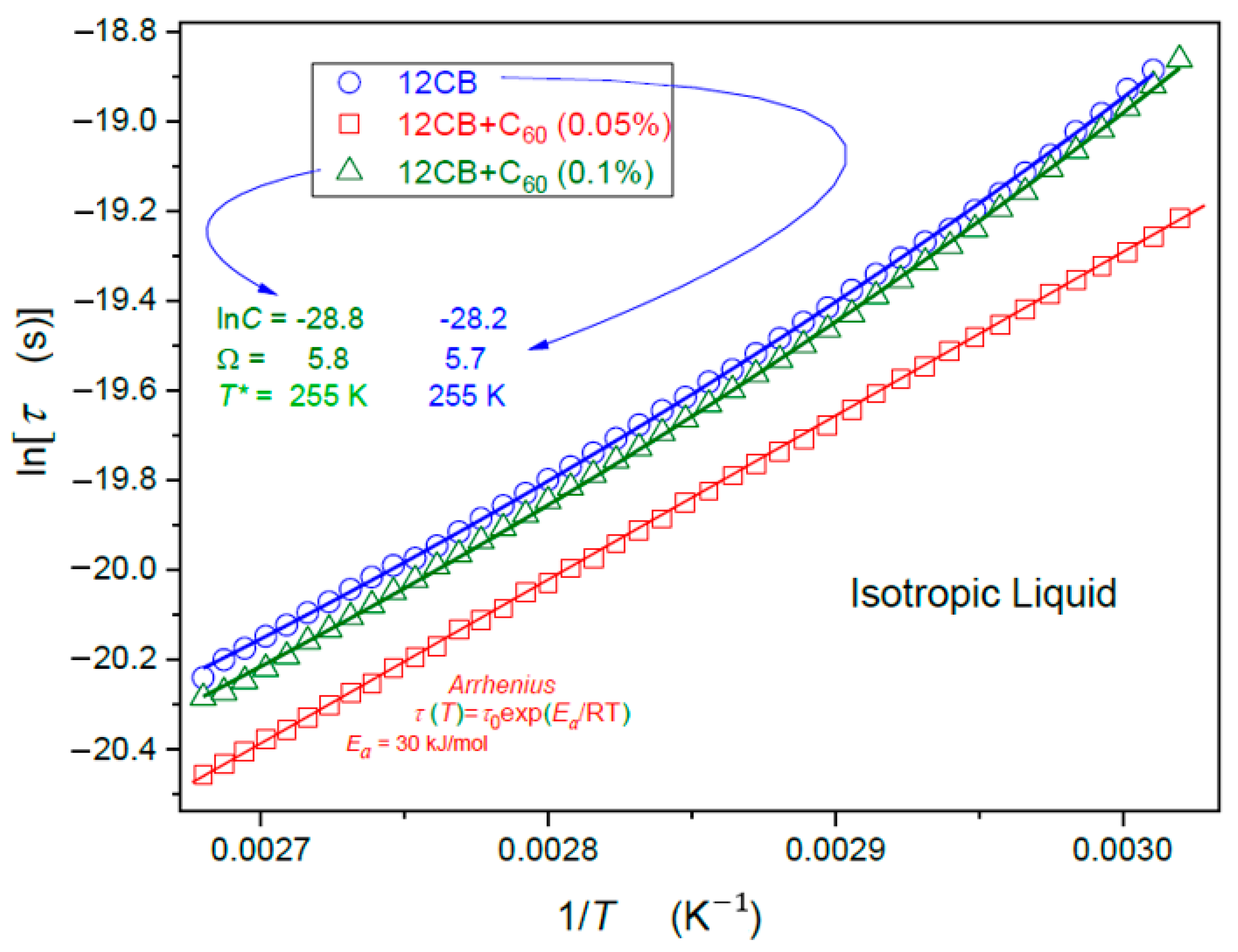
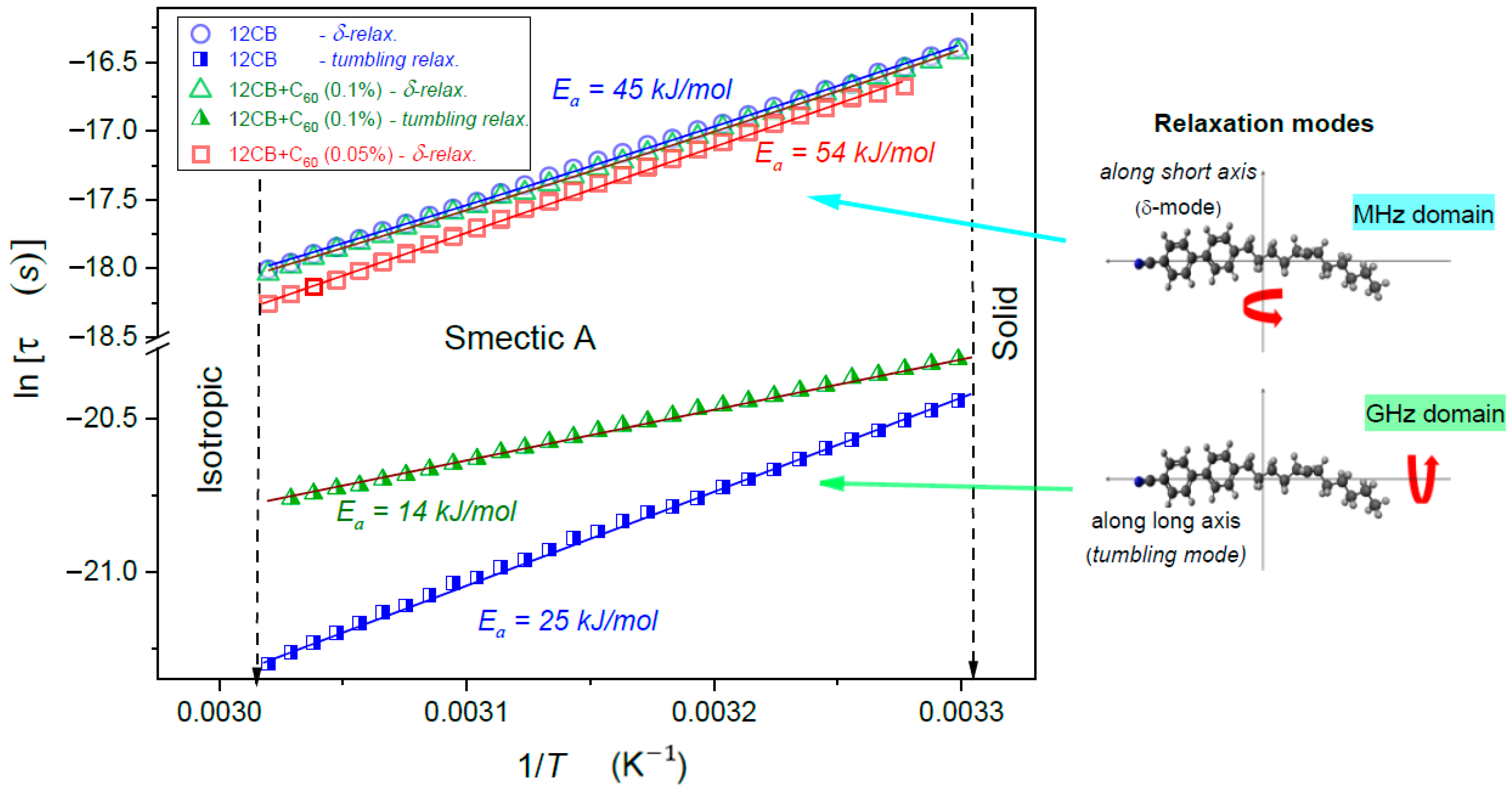
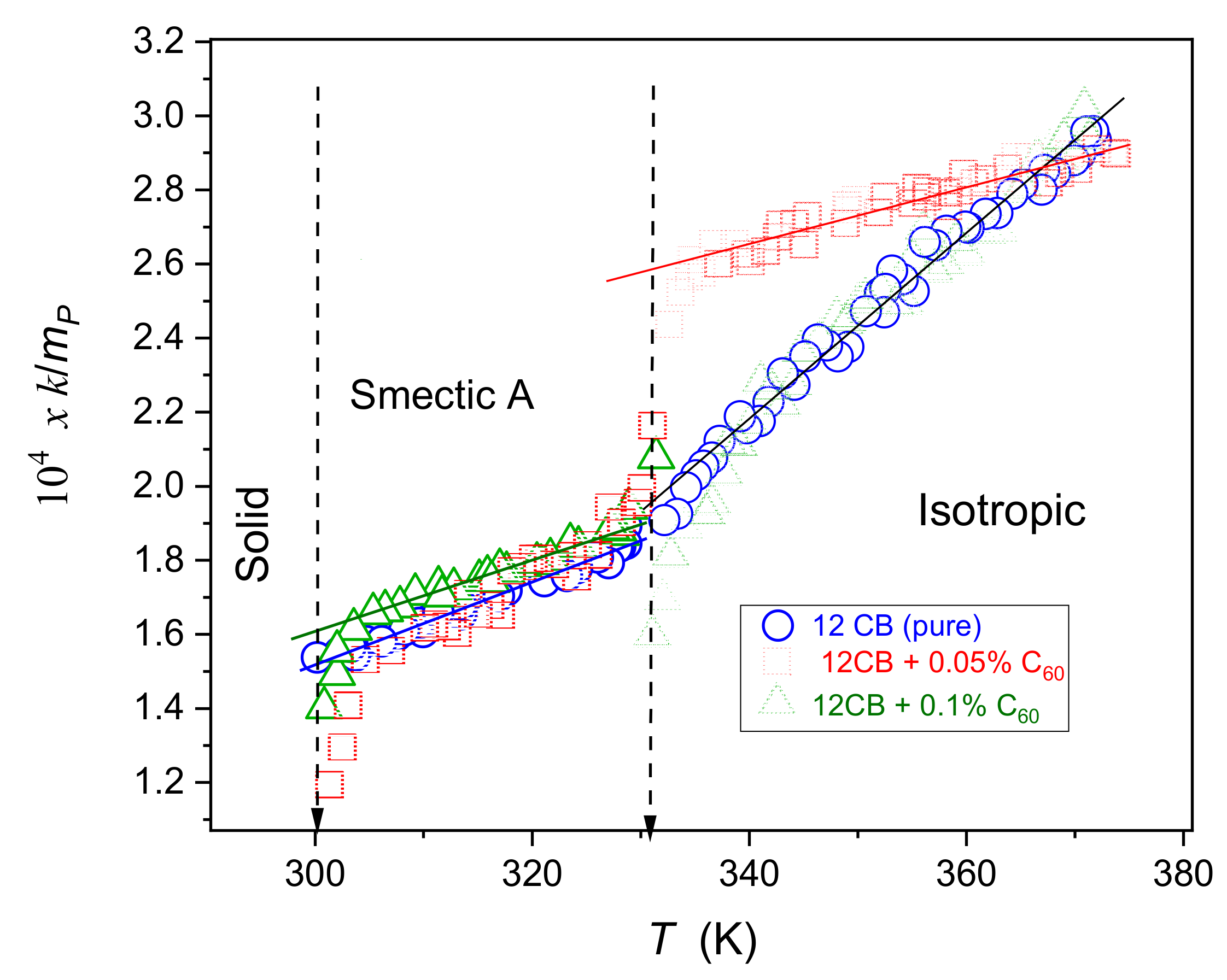
Publisher’s Note: MDPI stays neutral with regard to jurisdictional claims in published maps and institutional affiliations. |
© 2020 by the authors. Licensee MDPI, Basel, Switzerland. This article is an open access article distributed under the terms and conditions of the Creative Commons Attribution (CC BY) license (http://creativecommons.org/licenses/by/4.0/).
Share and Cite
Rzoska, S.J.; Starzonek, S.; Łoś, J.; Drozd-Rzoska, A.; Kralj, S. Dynamics and Pretransitional Effects in C60 Fullerene Nanoparticles and Liquid Crystalline Dodecylcyanobiphenyl (12CB) Hybrid System. Nanomaterials 2020, 10, 2343. https://doi.org/10.3390/nano10122343
Rzoska SJ, Starzonek S, Łoś J, Drozd-Rzoska A, Kralj S. Dynamics and Pretransitional Effects in C60 Fullerene Nanoparticles and Liquid Crystalline Dodecylcyanobiphenyl (12CB) Hybrid System. Nanomaterials. 2020; 10(12):2343. https://doi.org/10.3390/nano10122343
Chicago/Turabian StyleRzoska, Sylwester J., Szymon Starzonek, Joanna Łoś, Aleksandra Drozd-Rzoska, and Samo Kralj. 2020. "Dynamics and Pretransitional Effects in C60 Fullerene Nanoparticles and Liquid Crystalline Dodecylcyanobiphenyl (12CB) Hybrid System" Nanomaterials 10, no. 12: 2343. https://doi.org/10.3390/nano10122343
APA StyleRzoska, S. J., Starzonek, S., Łoś, J., Drozd-Rzoska, A., & Kralj, S. (2020). Dynamics and Pretransitional Effects in C60 Fullerene Nanoparticles and Liquid Crystalline Dodecylcyanobiphenyl (12CB) Hybrid System. Nanomaterials, 10(12), 2343. https://doi.org/10.3390/nano10122343





